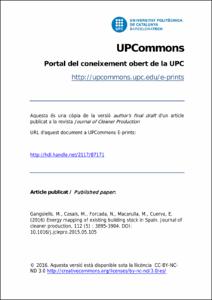Mostra el registre d'ítem simple
Energy mapping of existing building stock in Spain
| dc.contributor.author | Gangolells Solanellas, Marta |
| dc.contributor.author | Casals Casanova, Miquel |
| dc.contributor.author | Forcada Matheu, Núria |
| dc.contributor.author | Macarulla Martí, Marcel |
| dc.contributor.author | Cuerva Contreras, Eva |
| dc.contributor.other | Universitat Politècnica de Catalunya. Departament d'Enginyeria de Projectes i de la Construcció |
| dc.date.accessioned | 2016-05-18T15:42:30Z |
| dc.date.available | 2018-02-01T01:30:32Z |
| dc.date.issued | 2016-01-20 |
| dc.identifier.citation | Gangolells, M., Casals, M., Forcada, N., Macarulla, M., Cuerva, E. Energy mapping of existing building stock in Spain. "Journal of cleaner production", 20 Gener 2016, vol. 112, núm. 5, p. 3895-3904. |
| dc.identifier.issn | 0959-6526 |
| dc.identifier.uri | http://hdl.handle.net/2117/87171 |
| dc.description.abstract | Energy performance certificate databases are a key tool for mapping national building stock and thus fostering greater overall energy efficiency. This paper presents an insight into the energy performance of residential and tertiary sector buildings in Spain, through an analysis of the first 129,635 energy performance certificates issued for existing buildings, collected by the Catalan Institute of Energy. Most of the residential buildings or building units that were studied were “E” class (53.6%). Single-family houses were found to use more energy on average (248.0 kWhp/m2) than individual dwellings (183.2 kWhp/m2). Tertiary sector buildings were found to have slightly better energy performance (26.4% of buildings were rated “D class”), with an average energy consumption of 317.8 kWhp/m2. Modern buildings consume less energy, as they must meet the higher energy performance requirements stated in thermal building regulations. Residential buildings or building units located in hotter climate zones consume slightly less energy than those located in colder zones, mainly because heating accounts for a high percentage of overall energy expenditure (70–75% in residential buildings). A significant proportion of the energy consumed in tertiary sector buildings is for lighting (37.2%). This research defines the current energy consumption baseline of existing buildings in Spain. The results can help to prioritize energy conservation efforts according to building type, construction period, climate zone and specific end-uses. They may also help public authorities to plan future energy policies, and construction practitioners to identify market segments and business strategies. |
| dc.format.extent | 10 p. |
| dc.language.iso | eng |
| dc.rights.uri | http://creativecommons.org/licenses/by-nc-nd/3.0/es/ |
| dc.subject | Àrees temàtiques de la UPC::Energies::Eficiència energètica |
| dc.subject.lcsh | Buildings--Energy conservation--Law and legislation--Spain |
| dc.subject.lcsh | Energy consumption |
| dc.subject.other | Energy performance certificates |
| dc.subject.other | Energy certification |
| dc.subject.other | Energy consumption |
| dc.subject.other | Buildings |
| dc.subject.other | Spain |
| dc.title | Energy mapping of existing building stock in Spain |
| dc.type | Article |
| dc.subject.lemac | Energia -- Consum -- Edificis |
| dc.subject.lemac | Energia -- Estalvi -- Avaluació -- Dret i legislació -- Certificació |
| dc.subject.lemac | Energia -- Estalvi -- Dret i legislació -- Espanya |
| dc.contributor.group | Universitat Politècnica de Catalunya. GRIC - Grup de Recerca i Innovació de la Construcció |
| dc.identifier.doi | 10.1016/j.jclepro.2015.05.105 |
| dc.description.peerreviewed | Peer Reviewed |
| dc.relation.publisherversion | http://www.sciencedirect.com/science/article/pii/S0959652615006848 |
| dc.rights.access | Open Access |
| local.identifier.drac | 17738403 |
| dc.description.version | Postprint (author's final draft) |
| local.citation.author | Gangolells, M.; Casals, M.; Forcada, N.; Macarulla, M.; Cuerva, E. |
| local.citation.publicationName | Journal of cleaner production |
| local.citation.volume | 112 |
| local.citation.number | 5 |
| local.citation.startingPage | 3895 |
| local.citation.endingPage | 3904 |
Fitxers d'aquest items
Aquest ítem apareix a les col·leccions següents
-
Articles de revista [360]
-
Articles de revista [168]


